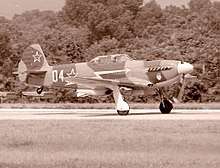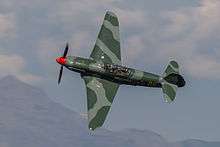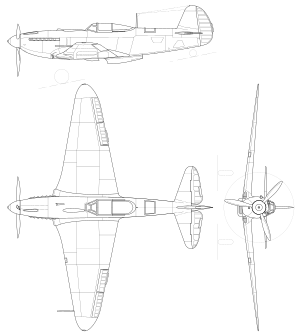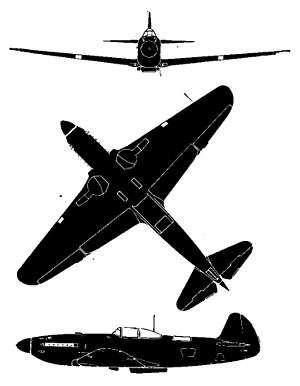Yakovlev Yak-9
The Yakovlev Yak-9 (Russian: Яковлев Як-9) was a single-engine single-seat multipurpose fighter aircraft used by the Soviet Union in World War II and after. Fundamentally a development of the robust and successful Yak-7B fighter based in turn on a tandem-seat advanced trainer Yak-7UTI, the Yak-9 arrived to Soviet fighter aviation regiments at the Stalingrad Front in December 1942 and played a major role in taking air superiority over Luftwaffe aces on the new Focke-Wulf Fw 190 and Messerschmitt Bf 109G fighters during the grand Battle of Kursk in summer 1943.
| Yak-9 | |
|---|---|
_(39004376092).jpg) | |
| Yak-9U fighter in the Central Air Force Museum, Monino, Russia | |
| Role | Fighter |
| National origin | Soviet Union |
| Design group | A.S. Yakovlev Design Bureau |
| Built by | Plant No.153 (Novosibirsk), Plant No.166 (Omsk), Plant No.82 (Moscow) |
| First flight | 6 July 1942 (Yak-7DI) |
| Introduction | October 1942 |
| Retired | 1950 (Soviet Air Forces), 1951 (Korean People's Army Air and Anti-Air Force), 1955 (Bulgarian Air Force) |
| Primary users | Soviet Air Forces |
| Produced | September 1942 – December 1948 |
| Number built | 16,769[1] |
| Developed from | Yakovlev Yak-7 |
The Yak-9 had a lowered rear fuselage decking and all-around vision canopy. Its lighter metal longerons gave the new fighter a potential to increase fuel load and armament that previous models with wooden airframe had lacked.[2] The maneuverable, high-speed at low/medium altitudes and easy to control Yak-9 was one of the best and the most mass-produced Soviet fighter of World War II. It was produced in different variants including the Yak-9T with the 37 mm and the "large-calibre" Yak-9K with the 45 mm cannon firing through propeller hub to be effectively used against enemy tanks and aircraft, the fighter-bomber Yak-9B with the inner hanger behind cockpit of up to 400 kg bombs, the long-range Yak-9D and the Yak-9DD with additional wing fuel tanks to escort Allied bombers over Eastern Europe, the Yak-9U with the more powerful engine and improved aerodynamics. The Yak-9 remained in production from 1942 to 1948, with 16,769 built (14,579 during the war).[3].
Following World War II, the Yak-9 was used also by the North Korean Air Force during the Korean War.[4]
Design and development
The Yak-9 represented further development of the successful Yakovlev Yak-7 fighter, a production version of the lightened Yak-7DI, taking full advantage of the combat experience with its predecessor. Greater availability of duralumin allowed for lighter construction which in turn permitted a number of modifications to the basic design. Yak-9 variants carried two different wings, five different engines, six different fuel tank combinations and seven types of armament configurations.
Yak-9U
During December 1943, the creation of a new airframe (Yak-9U) allowed the installation of the M-107A engine, which was more powerful than the previous VK-105PF. The engine mount was brand new and included individual faired exhaust pipes, wings, and fuselage structure that was made of metal while the whole aircraft received a covering of Bakelite skin. The horizontal tail surfaces were slightly reduced in order to afford the aircraft improved pitch control. The oil cooler intake was moved from beneath the nose to the port wing root as well as an enlarged radiator bath being moved further aft under the fuselage. A supercharger intake was centered on the top decking of the engine cowling. The rear antenna cable was moved inside a lengthened rear canopy which featured a more aerodynamically refined shape with a modified fuselage deck contour. The typical armament of the Yak-9U was a 20mm (79 cal) ShVAK cannon with 120 rounds that was fired through the aircraft's hollow propeller shaft, and two 12.7mm (50 cal) Berenzin UB machine guns with 340 rounds.[5]
January to April 1944 marked the commencement of State trials and revealed that the Yak-9U had a superior top-speed compared to all fighters in service on the Eastern front at 6,000m (19,685ft). Unlike the I-185 the Yak-9U was a much simpler to fly and stable aircraft. Ultimately the M-107A engine inherited all the problems of the VK-105PF engine. The engine was prone to overheating, oil leaks, loss of engine pressure during climbs, spark plugs constantly burning out, and intense vibrations which would fatigue assembly bolts leading to a short engine life. These defects forced the first production batches starting during April 1944 to be powered by the reliable M-105 PF-3 engine. Further changes would include the fuel capacity of the Yak-9U being upgraded to 400L (106 US gal) and in order to re-balance the aircraft, the wings were moved 9.906 centimeters (3.9in) forward and the aircraft's Vlsh-107LO propeller being replaced with the older VISH-105S. A total production of 1,134 aircraft where constructed by December 1944.[6]
Operational history
Second World War
The first Yak-9 entered service in October 1942 and first saw combat in late 1942 during the Battle of Stalingrad. The versatile Yak-9 operated with a wide variety of armament for use in anti-tank, light bomber and long-range escort roles. At low altitude, in which it operated predominantly, the Yak-9 was more maneuverable than its main foe, the Bf 109, but was far less well armed. A series of improvements in performance and armament did not hamper the superb handling characteristics that allowed its pilots to excel at dog-fighting. Soviet pilots regarded the Yak-9's performance as on the same level as the Bf 109G and Fw 190A-3/A-4.[7] After the Battle of Smolensk, in the second half of 1943, the famed Free French Normandie-Niémen unit became a Groupe and was equipped with the Yak-9.[8]
The first unit to use the Yak-9U, between 25 October and 25 December 1944, was 163.IAP. Pilots were ordered not to use the engine at combat speed since this reduced its life to two or three flights only. Nevertheless, in the course of 398 sorties, the unit claimed 27 Focke-Wulf Fw 190As and one Bf 109G-2, for the loss of two Yaks in dogfights, one to flak and four in accidents. The Yak-9U contributed greatly to Soviet air superiority, and the Germans avoided the Yaks “without antenna mast”.[9]
A large formation of the Yak-9DD version was transferred to Bari (the capital of Apulia, in Italy) to help Yugoslav partisans in the Balkans.[10]
One of the top-scoring Yak-9 pilots was First Lieutenant A.I. Vybornov. Flying a type-T (equipped with a 37mm NS-37 cannon in the nose) he achieved 19 air victories, plus nine shared. He was awarded the Gold Star Medal of the Hero of the Soviet Union in June 1945.[11] At the end of the war, on 22 March 1945, Lieutenant L.I. Sivko from 812th IAP achieved the air victory against a Messerschmitt Me 262 jet fighter, but he was killed soon afterward by another Me 262, probably piloted by Franz Schall, a top-scoring Me 262 pilot.[12]
Fighter units with this aircraft suffered lower losses than average. Of 2,550 Yak-9s manufactured up the end of 1943, only 383 were lost in combat. [13]
Post-war era
During 1949, the Soviet Union provided surplus Yak-9P (VK-107) aircraft to some satellite states in the Soviet bloc in order to help them rebuild their air forces in the wake of the West Berlin blockade. A section of the aircraft's operating manual was accidentally omitted from the translation from Russian into some languages: before starting the Yak-9, it was necessary to hand-crank a small cockpit-mounted oil pump 25 times to provide initial lubrication to the Klimov V12 engine, unlike World War II German and Western fighters equipped with forced closed-cycle lubrication systems. Skipping this unusual but vital step resulted in frequent engine seizures during the takeoff roll and initial climb, causing several fatalities during 1950.
Variants

Yakovlev OKB created 22 modifications of the Yak-9, of which 15 saw mass production. The most notable of these include:
- Yak-9
First production version, Klimov M-105PF engine with 880 kW (1,180 hp), 1 × 20 mm ShVAK cannon with 120 rounds and 1 × 12.7 mm UBS machine gun with 200 rounds.
- Yak-9 (M-106)
Prototype with Klimov M-106-1SK engine with 1,007 kW (1,350 hp), did not advance to production because of problems with the engine.
- Yak-9T
Yak-9 armed with a 37 mm Nudelman-Suranov NS-37 cannon with 30 rounds instead of the 20 mm ShVAK, cockpit moved 0.4 m (1 ft 3 in) back to compensate for the heavier nose. Initially poor quality control led to multiple oil and coolant leaks from cannon recoil.(It was a problem only during the prototype tests:[14] )Recoil and limited supply of ammunition required accurate aiming and two-three round bursts. Yak-9T was widely used against enemy shipping on the Black Sea and against tanks (the cannon could penetrate up to 30 mm armor from 500 m), but was also successful against aircraft with a single cannon hit usually sufficient to tear apart the target. Virage (constant altitude and velocity turn) time: 18–19 seconds. 2748 were produced.[15]

- Yak-9K
Yak-9T modified with a 45 mm NS-45 cannon with 29 rounds and a distinctive muzzle brake to deal with the massive recoil. Firing the cannon at speeds below 350 km/h (220 mph) caused dramatic loss of control and tossed the pilot back and forth in the cockpit; however, accurate shooting was possible at higher speeds and in 2–3 round bursts. The recoil also caused numerous oil and coolant leaks. The heavy cannon installation degraded performance, even more so at high altitudes, sufficiently to relegating the Yak-9K to be used as a heavy fighter and resulting in the need for a fighter escort of Yak-3s. The Yak-9K saw only limited use due to unreliability of the NS-45, airframe performance issues caused by both the NS-45 and larger fuel tanks used on the Yak-9K, as well as a reduction of bombers used by the Germans.

- Yak-9D
Long-range version of Yak-9, fuel capacity increased from 440 l (115 US gal) to 650 l (170 US gal) giving a maximum range of 1,400 km (870 mi). Combat usefulness at full range was limited by lack of radio navigation equipment, and a number of aircraft were used as short-range fighters with fuel carried only in inner wing tanks. Circle time: 19–20 sec. Weight of fire: 2 kg (4.4 lb)/sec.
- Yak-9TD
Yak-9D with NS-37 cannon and provision for 4 × 50 kg (110 lb) FAB-50 bombs under the wings.
- Yak-9B
Fighter-bomber version of Yak-9D (factory designation Yak-9L) with four vertical tube bomb bays aft of the cockpit with capacity for up to 4 × 100 kg (220 lb) FAB-100 bombs or 4 PTAB cassettes with 32 × 1.5 kg (3.3 lb) bomblets each, although normally only 200 kg (440 lb) of weapons were carried in the front bomb bays. Poor handling with a full bomb and fuel load and lack of special aiming equipment limited combat usefulness.
- Yak-9DD
Yak-9D and Yak-9T modified to further increase the range, fuel capacity increased to 845 l (220 US gal) giving a maximum range of 2,285 km (1,420 mi), radio navigation equipment for night and poor weather flying. Yak-9DD were used primarily to escort Petlyakov Pe-2 and Tupolev Tu-2 bombers although they proved less than ideal for this role due to insufficient speed advantage over the bombers. In 1944, several Yak-9DD were used to escort B-17 Flying Fortress and B-24 Liberator bombers attacking targets in Romania using the Ukraine-Romania-Italy routes.
- Yak-9M
Yak-9D with the cockpit moved 0.4 m (1 ft 4 in) to the rear like on Yak-9T, numerous fixes and improvements based on experience with previous versions.
- Yak-9M PVO
Yak-9M with slightly reduced fuel capacity, Klimov VK-105PF2 engine with 925 kW (1,240 hp), and radio and navigational equipment for night and adverse weather flying for PVO Strany.

- Yak-9 MPVO
Single-seat night fighter aircraft, equipped with a searchlight and an RPK-10 radio compass.
- Yak-9S
Yak-9M with Klimov VK-105PF engine, new propeller, and armament consisting of 1 × 23 mm Nudelman-Suranov NS-23 cannon with 60 rounds, and 2 × 20 mm Berezin B-20 cannons with 120 rpg. Did not enter production due to poor performance compared to Yak-3 and Yak-9U.
- Yak-9R
Single-seat tactical reconnaissance aircraft.
- Yak-9P

This aircraft was the last and the most advanced version of the Yak-9 fighter, which became the pinnacle of development among A. S. Yakovlev's piston-engined fighters. The Yak-9P (Product P) that appeared in 1946 was a modification of the Yak-9U fighter of composite construction. Unlike its predecessor, it had all-metal wings with elliptical tips. By this time, the manufacture of high-strength aluminum alloys was established in the Soviet Union, simplifying aircraft operation and increasing aircraft service life.
- Yak-9P (VK-107)
Yak-9U with an all-metal wing, Yak-9P in this case was a factory designation different from Yak-9P with two ShVAKs (see above).
- Yak-9PD
High-altitude interceptor (unrelated to the two other Yak-9P above) with Klimov M-105PD engine designed specifically to intercept Luftwaffe Junkers Ju 86P high-altitude reconnaissance aircraft overflying Moscow in 1942–1943. Initially poor performance due to unreliable engine dramatically improved with adoption of Klimov M-106PV with water injection, with the aircraft reaching 13,500 m (44,300 ft) during testing. Armament reduced to the ShVAK cannon only to save weight.
- Yak-9U (VK-105)
Yak-9T with Klimov VK-105PF2 engine and numerous aerodynamic and structural improvements introduced on Yak-3. Main visual difference from Yak-9T was in the oil coolers in the wing roots like on Yak-3 and in plywood covering of the fuselage instead of fabric. Visually differed from Yak-3 only by main landing gear covers. Armament increased to 1 × 23 mm VYa with 60 rounds and 2 × 12.7 mm UBSs with 170 rpg. The VYa cannon could be replaced by a ShVAK, B-20, or NS-37, the latter requiring removal of the starboard UBS machine gun. Did not enter production because the VYa cannon was considered unsatisfactory and because the one cannon, one machine gun armament seen on previous models offered a significant increase in range.
- Yak-9U (VK-107)
The definitive Yak-9 variant, Yak-9U (VK-105) equipped with the new Klimov VK-107A engine with 1,230 kW (1,650 hp), and the 20 mm ShVAK with 120 rounds replacing the VYa. Weight of fire: 2.72 kg (5.98 lb)/sec. Early test flights in 1943 indicated that the only comparable Soviet fighter was Polikarpov I-185 prototype which was more difficult to fly and less agile due to higher weight. The prototype's top speed of 700 km/h (435 mph) at 5,600 m (18,370 ft) was faster than any other production fighter aircraft in the world at the time, other than the P-51B that could reach up to 441 mph on military power.[16] Early problems with overheating were fixed by enlarging the radiators and production aircraft had further improved aerodynamics. Turning ability to complete a circle: 23 sec, best Soviet fighter at altitude.
- Yak-9UV
Two-seat trainer version of Yak-9U (VK-107), armament reduced to a single Berezin B-20 cannon with 100 rounds. Did not enter production due to introduction of jet aircraft.
- Yak-9UT
Yak-9U (VK-107) armed with 1 × 37 mm Nudelman N-37 cannon with 30 rounds and 2 20 mm Berezin B-20 cannons with 120 rpg, giving a one-second burst mass of 6 kg (13.2 lb). Similarly to Yak-9TK could be converted to replace the N-37 with a 20 mm B-20, 23 mm NS-23, or 45 mm N-45. Production aircraft carried NS-23 instead of the N-37 cannon as the default armament.
- Yak-9V
Two-seat trainer version of Yak-9M and Yak-9T, Klimov VK-105PF2 engine, armament reduced to 1 × 20 mm ShVAK with 90 rounds.
- Modern replicas
In the early 1990s, Yakovlev started limited production for the warbird market of Yak-9 and Yak-3 replica aircraft using original World War II equipment and Allison V-1710 engines. These modern-built replicas using the Allison engines, have counterclockwise-rotation props, unlike the originals which strictly used clockwise-rotation Soviet V12 powerplants.
Operators
- Albanian Air Force received 72 aircraft in 1947, including 12 Yak-9V trainers.
- Armée de l'Air
- Normandie-Niemen squadron
- Hungarian Air Force received aircraft in 1949. The type's Hungarian name was "Vércse" (Kestrel).
- Mongolian People's Army Aviation received 34 aircraft in late June 1945.
- North Korean Air Force
- Air Force of the Polish Army
- Polish Air Force operated several aircraft from 1947 to 1953.
- Polish Navy
- Soviet Air Force
- Soviet Air Defence Forces
- SFR Yugoslav Air Force – 16 Yak-9T, 40 Yak-9P, 47 Yak-9D/M and 68 Yak-9V aircraft in 1944–1950/1960[17]
- 111th Fighter Aviation Regiment (1947–1948)
- 112th Fighter Aviation Regiment (1947–1948)
- 94th Fighter Aviation Regiment (1948–1952)
- 116th Fighter Aviation Regiment (1948–1950)
- 117th Fighter Aviation Regiment (1948–1950)
- 141st Training Aviation Regiment (1952–1953)
- 2nd Training Aviation Regiment (1946–1948)
- 101st Fighter-Training Aviation Regiment (1948–1950)
- 103rd Reconnaissance Aviation Regiment (1950–1951)
- 104th Training Aviation Regiment (1948–1950)
- Training Squadron of 32nd Aviation Division (1953–1959)
- Training Squadron of 39th Aviation Division (1953–1959)
- Training Squadron of 44th Aviation Division (1953–1954)
Surviving aircraft
- Bulgaria
- Aviation Museum, Plovdiv - Yak-9P, tactical number 27
- Poland
- Museum of the Polish Navy, Gdynia - Yak-9P, tactical number 2, used by the Navy Aviation Escadrille until 1956. On 12 December 1956, transferred to the museum on behalf of the Navy Command.
- Museum of the Polish Army, Warsaw - Yak-9P, tactical number 23, used by the 1st Fighter Aviation Regiment from 1947 until 1950. Transferred to the museum on 10 August 1950 on behalf of the Air Force Command.
- Russia
- Central Air Force Museum, Monino, Moscow Oblast - Yak-9U
- Technical Museum of Vadim Zadorozhny, Krasnogorsky District, Moscow Oblast - Yak-9
- Museum of the Air Forces of the Northern Fleet, Safonovo, Murmansk Oblast - Yak-9R
- Serbia
- Museum of Aviation, Belgrade
- Ukraine
- Museum of the Great Patriotic War, Kiev
- United States
- The Museum of Flight, Seattle, WA - Yak-9U[18]
Specifications (Yak-9)

Data from [19]
General characteristics
- Crew: 1
- Length: 8.5 m (27 ft 11 in)
- Wingspan: 9.74 m (31 ft 11 in)
- Height: 3 m (9 ft 10 in)
- Wing area: 17.15 m2 (184.6 sq ft)
- Airfoil: root: Clark YH (14%) ; tip: Clark YH (10%)[20]
- Empty weight: 2,277 kg (5,020 lb)
- Gross weight: 2,870 kg (6,327 lb)
- Powerplant: × Klimov M-105PF V-12 liquid-cooled piston engine, 880 kW (1,180 hp)
- Propellers: 3-bladed constant-speed propeller
Performance
- Maximum speed: 600 km/h (370 mph, 320 kn) at 4,300 m (14,108 ft)
- Range: 910 km (570 mi, 490 nmi)
- Service ceiling: 11,100 m (36,400 ft)
- Rate of climb: 16.3 m/s (3,210 ft/min)
- Wing loading: 167.3 kg/m2 (34.3 lb/sq ft)
- Power/mass: 0.3066 kW/kg (0.1865 hp/lb)
Armament
- Guns:
- 1 × 20 mm ShVAK cannon, 120 rounds
- 1 × 12.7 mm Berezin UBS machine gun, 200 rounds
See also
Related development
Aircraft of comparable role, configuration and era
- Bell P-39 Airacobra
- North American P-51 Mustang
- Messerschmitt Bf 109
- Focke-Wulf Fw 190
- Supermarine Spitfire
Related lists
References
Notes
- Yakubovich 2008, p. 101.
- Gustin 2003, p. 120.
- Drabkin 2007, p. 146.
- Angelucci and Matricardi 1978, p. 246.
- "Yak-9U > WW2 Weapons". WW2 Weapons. 2019-02-27. Retrieved 2019-10-22.
- "Yak-9U > WW2 Weapons". WW2 Weapons. 2019-02-27. Retrieved 2019-10-22.
- Morgan 1999, p. 52.
- Morgan 1999, p. 24.
- Leonard 2005, p. 125.
- Gunston 1984, p. 256.
- Morgan 1999, p. 33.
- Morgan 1999, p. 53.
- Bergstrom 2008, p. 32.
- Yakovlev’s Piston-Engined Fighters (Red Star №5) by Yefim Gordon and Dmitriy Khazanov page 65.
- Aircraft of the USSR - book 2. TsAGI.
- "ARMY AIR FORCES MATERIAL COMMAND FLIGHT SECTION". wwii aircraft performance. Retrieved 11 October 2015.
- Yugoslav Air Force 1942–1992, Bojan Dimitrijevic, Belgrade 2006
- "Yakovlev Yak-9U Frank". The Museum of Flight. The Museum of Flight. Retrieved 27 January 2017.
- Shavrov 1994
- Lednicer, David. "The Incomplete Guide to Airfoil Usage". m-selig.ae.illinois.edu. Retrieved 16 April 2019.
Bibliography
- Angelucci, Enzo and Paolo Matricardi. World Aircraft: World War II, Volume II (Sampson Low Guides). Maidenhead, UK: Sampson Low, 1978. ISBN 0-562-00096-8.
- Bergström, Christer. Bagration to Berlin – The final Air Battle in the East 1944–45. Hersham, UK: Classic Publications, 2008. ISBN 978-1-903223-91-8.
- Bock, Robert. Yak-7, Yak-9 (Aircraft Monograph 14) (English translation of Polish original). Gdańsk, Poland: AJ-Press, 1999. ISBN 83-7237-020-6.
- Drabkin, Artem. The Red Air Force at War: Barbarossa and The Retreat to Moscow – Recollections of Fighter Pilots on the Eastern Front. Barnsley, South Yorkshire, UK: Pen & Sword Military, 2007. ISBN 1-84415-563-3.
- Gordon, Yefim and Dmitri Khazanov. Soviet Combat Aircraft of the Second World War, Volume One: Single-Engined Fighters. Earl Shilton, Leicester, UK: Midland Publishing Ltd., 1998. ISBN 1-85780-083-4.
- Green, William. Warplanes of the Second World War, Volume Three: Fighters. London: Macdonald & Co. (Publishers) Ltd., 1961 (seventh impression 1973). ISBN 0-356-01447-9.
- Green, William and Gordon Swanborough. WW2 Aircraft Fact Files: Soviet Air Force Fighters, Part 2. London: Macdonald and Jane's Publishers Ltd., 1978. ISBN 0-354-01088-3.
- Gunston, Bill. Aerei della 2ª Guerra Mondiale (in Italian ). Milan: Alberto Peruzzo Editore, 1984. NO ISBN.
- Gunston, Bill. The illustrated Directory of Fighting Aircraft of World War II. London: Salamander Book Limited, 1988. ISBN 1-84065-092-3.
- Kopenhagen, W., ed. Das große Flugzeug-Typenbuch (in German). Stuggart, Germany: Transpress, 1987. ISBN 3-344-00162-0.
- Leonard, Herbert. Encyclopaedia of Soviet Fighters 1939–1951. Paris: Histoire & Collections, 2005. ISBN 2-915239-60-6.
- Liss, Witold. The Yak 9 Series (Aircraft in Profile number 185). Leatherhead, Surrey, UK: Profile Publications Ltd., 1967.
- Mellinger, George. Yakovlev Aces of World War 2. Botley, UK: Osprey Publishing Ltd., 2005. ISBN 1-84176-845-6.
- Morgan, Hugh. Gli assi Sovietici della Seconda guerra mondiale (in Italian). Milano: Edizioni del Prado/Osprey Aviation, 1999. ISBN 84-8372-203-8.
- Morgan, Hugh. Soviet Aces of World War 2. London: Reed International Books Ltd., 1997. ISBN 1-85532-632-9.
- Panek, Robert. Yakovlev Yak-9U & P. Sandomierz, Poland/Redbourn, Hertfordshire, UK: Mushroom Model Publications, 2006. ISBN 83-89450-27-5.
- Шавров, В.Б. История конструкций самолетов в СССР 1938–1950 гг. (3 изд.). Kniga: Машиностроение, 1994 (Shavrov, V.B. Istoriia konstruktskii samoletov v SSSR, 1938–1950 gg.,3rd ed. History of Aircraft Design in USSR: 1938–1950). Kniga, Russia: Mashinostroenie, 1994.) ISBN 5-217-00477-0.
- Stapfer, Hans-Heiri. Yak Fighters in Action (Aircraft number 78). Carrollton, Texas: Squadron/Signal Publications, Inc., 1986. ISBN 0-89747-187-3.
- Степанец, А.Т. Истребители ЯК периода Великой Отечественной войны. Kniga: Машиностроение, 1992. Stepanets, A.T. Istrebiteli Yak perioda Velikoi Otechestvennoi voiny (Yak Fighters of the Great Patriotic War). Kniga, Russia: Mashinostroenie, 1992. ISBN 5-217-01192-0.
- Williams, Anthony G. and Emmanuel Gustin. Flying Guns: The Development of Aircraft Guns, Ammunition and Installations 1933–45. Ramsbury, UK: Airlife, 2003. ISBN 1-84037-227-3.
- Якубович, Н.В. Истребитель Як-9. Заслуженный «фронтовик». Москва: Коллекция, Яуза, ЭКСМО, 2008. Yakubovich, N.V. Istrebitel’ Yak-9. Zasluzhenny ”frontovik” (Yak-9 Fighter. A Honored “Veteran”). Moscow, Russia: Collection, Yauza, EKSMO, 2008. ISBN 978-5-699-29168-7.
External links
| Wikimedia Commons has media related to Yakovlev Yak-9. |